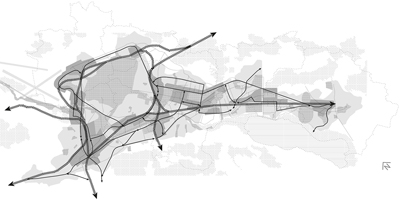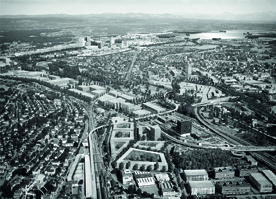You are in: Home page > Magazine Archive > Redefining sprawl

Nicola Vazzoler
Redefining sprawl
The city of Glatt
The term sprawl generally denotes a phenomenon of old origin (Secchi, 2008), global scale and local characteristics (Lanzani et al, 2011) that has now become so widespread as to raise a number of issues connected to its sustainability. With respect to this, it is necessary to think in terms of social, economic and environmental costs (Camagni et al, 2002) in order to understand the consequences of a sprawled model of urbanization on the territory. These consequences are sometimes interconnected.
What is known as soil consumption, for instance, has come to be seen both within the disciplinary and public debate as a fact that needs to be urgently addressed, a waste of limited resources which have probably been used inefficiently. In the last decade, the Italian soil consumption was not influenced – it seems – by demographic and economic factors, as opposed to neighboring Switzerland, where the demographic and economic growth keeps fuelling the pro-capita soil demand. The Confederation, by means of its new Spatial Planning Document (2012) which is now under approval, aims at limiting soil consumption, safeguarding landscape and fulfilling growth demands. The concept of centripetal development, which was already used in Switzerland’s “Programmi d’agglomerato”, is re-introduced. It entails a limit to urban developments and a greater exploitation of already urbanized areas, through densification processes promoting the quality of public space and urban developments. The aim is to monitor soil consumption in order to safeguard the territory against sprawl by adopting a compact urban model. The same issue was approached by European policies in a number of documents. The Green Paper on the Urban Environment (1990) against uncontrolled urban expansion envisaged among its objectives the need of a compact urban fabric. On different scales, the Aalborg Charter (1994) and the Leipzig Charter (2007) recognize the potential of a high urban density as well as the need of a compact urban structure for a sustainable urban development. Aimed at reducing urban proliferation, the European Spatial Development Perspective (1999) considers compact cities as a model. The recent Thematic Strategy on the Urban Environment (2006) promotes high density and mixed-use urban developments.
Since 2008, the Krokodil group works pro-bono on a study on urban planning for the peripheral area located north-east of Zurich, in the Glatt River Valley, consisting of 11 municipalities and 2 urban districts. The group attempts at implementing an urban model to the area, thereby promoting an urban lifestyle and compacting developments to counter increasing urban sprawl. As a result, the city of Glatt was born. As written in its manifesto (Roesler, 2012), the city is characterized by the awareness of the need of a responsible use of limited resources. Such awareness ensures the quality of living for the city’s inhabitants. Therefore the city, which is located within an area characterized by urban sprawl, aims at being compact and sustainable. Border areas between the different municipalities are treated by the group as new development areas, places in which new high density, mixed-use urban developments with quality green spaces can be concentrated. A number of city-planning tools, such as the Flächentransfer (similar to Italy’s perequazione urbanistica), can be implemented to transfer building rights from one place to another, thereby safeguarding areas from urban sprawl and producing density and compactness where desired. Such instruments are implemented on a large territorial scale. The distribution of density is then confronted with a variety of overlapping and interconnected networks governing and designing a polycentric urban structure: the “green” system, the transport system and the energy system. The “green system”, through a capillary network of different open spaces (ecologic corridors, urban and district parks) connecting the fragments produced by urban sprawl, promotes slow, bike and pedestrian mobility as well as environmental quality. Green areas ring built areas and new urban developments, thereby becoming the project’s backbone. Built areas surround the new public transport system (train, bus and tram lines), which is integrated with the already existing one, centered in Zurich. Traffic flows are sustained by the new compact, high density urban fabric located along the transport lines, which encourage a decrease in the use of less sustainable private transport. Thus, the project aims at redefining the sprawl landscape by means of a set of limitations, relations and concepts of a new compact, sustainable city.
Each crisis has brought about new awareness in matters of scarcity and limits. In the past the limit to city development and building used to be determined by technological or power deficits (Secchi, 2000), whereas it now seems to be determined by such awareness and the ensuing adoption of sustainable development models. In this epoch of “awarenesses”, cities seem to be seen as a resource – a renewable one in that they are stratified places consisting of recyclable urban materials (Viganò, 2012). In addition to that, cities are sometimes elevated to a model that can be used to redefine urban sprawl, as happens in the case of the Krokodil group.
Nicola Vazzoler, PhD candidate in Territorial Policies and Local Project at Scuola dottorale di Culture e Trasformazioni della Città e del Territorio, Roma Tre Università degli Studi, XXVII cycle.
Bibliography
Camagni R., Gibelli M.R., Rigamonti P. (2002). I costi collettivi della città dispersa, Firenze: Alinea.
Lanzani A., Pasqui G. (2011). L’italia al futuro. Città e paesaggi, economie e società, Milano: Alinea.
Roesler S. (2012). Glatt! Manifest für eine Stadt im Werden, Zürich: Park Books.
Secchi B. (2008). La città del ventesimo secolo, Bari: Editori Laterza
Secchi B. (2000). Prima lezione di urbanistica, Bari: Editori Laterza.
Viganò P. (2012). Riciclare città. In Ciorra P., Marini S. a cura di, RE-CYCLE.Strategie per l’architettura, la città e il pianeta, Milano: Electa, 102-119.
Piano Territoriale Svizzera (2012) (http://www.uvek.admin.ch/themen/02536/02545/02547/index.html?lang=it)
Carta di Lipsia (2007)
Strategia tematica sull’ambiente urbano (2006)
Schema di Sviluppo dello Spazio Europeo (1999) (http://europa.eu/legislation_summaries/regional_policy/management/g24401_it.htm)
Carta di Aalborg (1994)
Green Paper on the Urban Environment (1990) (http://ec.europa.eu/environment/urban/pdf/com90218final_en.pdf)















